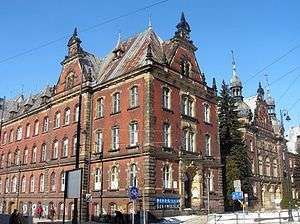Prussian Eastern Railway Headquarters in Bydgoszcz
| Prussian Eastern Railway Headquarters in Bydgoszcz | |
|---|---|
| Polish: Budynek Dyrekcji Kolei w Bydgoszczy | |
|
Prussian Eastern Railway Headquarters from Dworcowa Street | |
 Location within Poland | |
| Alternative names | Pomeranian Rail agency and Central Bureau of Foreign Settlements (1922-1939), Seat of French-Polish Rail Association (1937-1939) |
| General information | |
| Architectural style | Dutch Mannerism |
| Classification | N°601288-Reg.A/748, 10th Dec. 1971 |
| Address | Dworcowa st.63 |
| Town or city | Bydgoszcz |
| Country | Poland |
| Coordinates | 53°7′49″N 17°59′44″E / 53.13028°N 17.99556°E |
| Current tenants | Polish State Railways |
| Construction started | 1886 |
| Completed | 1889 |
| Client | Royal (Prussian) Directorate of Eastern Railway |
| Technical details | |
| Floor count | 4 |
| Design and construction | |
| Architect | Martin Gropius, Heino Schmieden |
| Wikimedia Commons has media related to Prussian Eastern Railway Headquarters in Bydgoszcz. |
The Prussian Eastern Railway Headquarters in Bydgoszcz is a historical building, formerly the seat of the Prussian Eastern Railway headquarters.
Location
The building is located at Dworcowa st.63, in downtown Bydgoszcz, on the embankment of to Brda river, approx. 300 meters from the main railway station. Until 1918, its address was "Bahnhofstraße 28, Bromberg".

History

Project inception
The Directorate of Prussian Railways in Bydgoszcz has been set in 1849 at Nowy Rynek 8, before moving in 1853 to the main train station building. As its activity expanded with the development of the Prussian Eastern Railway network, and despite the addition to the station of massive wings (1861), the edifice, in 1870 was almost entirely devoted to administrative purposes. The whole area was utilised, even the waiting room and the restaurant: the old main train station proved to be too narrow, and some departments had to be transferred to nearby rented houses (approx. 11 houses were hired in 1880).[1]
Soon arose the necessity of a new building. Architectural company for this project were chaired by Berliner architect Martin Gropius and economist Heino Schmieden: their firm was founded in 1866 and performed projects for private and state investors.
Philipp Martin Gropius, designer of the building, was a disciple of architects Schinkel and Beuth from Gewerbeinstitut Berlin. In 1855 he graduated from Bauakademie (Academy of Architecture) in Berlin, in 1862 he took the position of Landbaumeistra (domestic architect) in Berlin Police Construction agency. In 1869 he became director of the Royal School of Arts and Crafts in Berlin.
The project of a new building for the Directorate of Railways has been submitted in 1885 upon the Prussian parliament. Initial costs were estimated at approx. 2.5 million marks, too high for the Ministry of Public Works and it was necessary to rewrite the planin a cost effective manner. Martin Gropius was no more (he died in 1880), and his masterplan was redesigned by Bergmann Dahms, national building inspector. He located the area of the new building at Dworcowa st.63 (then Bahnhofstraße 28), approx. 20 m from the river bank and 300 meters from the railway station.[1]
The construction
Construction started in summer 1886, and ended middle of 1888. Bergmann Dahms has been managing the entire project, with state architect Richter supervising the sewering network and central heating installations.[1] Interior were designed using rich architectural forms and ornaments, emphasizing the importance, dignity and seriousness of the office and its charge. As a result, the work turned out a 4-storey building with 2 wings, which is still today one of the most representative buildings in Bydgoszcz. Shortly after the construction, on neighbouring Krolowej Jadwigi street, has been erected a smaller edifice with outbuildings, including garages and a high-stack boiler room.[1]
The scheme of the project (both facade displays and interiors) had to reflect the official Prussian style architecture. In this case, it referred to Mannerism, relatively rarely used in the official art of Prussia.[1]
Follow-up
The building remained the seat of the East Prussian Railways until Bydgoszcz reintegrates Polish territory on 1 August 1919. The new state administration created a Ministry of Railways in Warsaw, which appointed seven Directions of District State Railways, where Bydgoszcz was subordinated to the administration of DOKP in Gdansk. Consequently Bydgoszcz's building moved under the control of Department of Revenue, and in 1922 it housed an Office station. A year later, a medical Railway Clinic was set up there. After several changes of ownership, the Ministry of Communications moved a part of Gdansk headquarters back to the Dworcowa edifice (1 October 1933). At the same time, it has welcomed the Central Bureau of Foreign logistics ((Polish) Centralne Biuro Rozrachunków Zagranicznych PKP)[2] which is still located there today.
In 1937 the building housed the French-Polish Rail Association, a joint-stock company formed after the construction of railway line from Silesia to Gdynia.[3]
In 1945, building ownership moved to the National Treasury and passed back to Rail Administration in 1970. Since 1990 a large part of the premises is leased to numerous private and public companies. In October 2013 the building was handed to Collegium Medicum, Nicolaus Copernicus University in Torun, in order to install there dentistry faculty. Necessary renovations to adapt the building to the needs of the institution and its equipment will cost about 30 million zł.[4]
Architecture
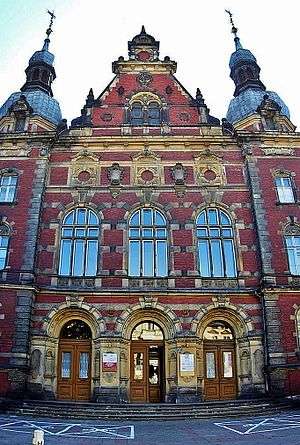
The building is built in a reminiscing Dutch Mannerism, with a tower and decorative gables. In Bydgoszcz, such a style can be noticed similarly on a building at Kołłątaja Street N°9 (former shelter for blind people) and on the Lloyd's Palace building at Grodzka St.17.[1]
Dworcowa edifice has been built on a rectangular plan, with 3 courtyards in the middle of the building. Building body is covered with high gable roofs and 2 avant-corps front Towers topped with domes. The front elevation has highly detailed stone decoration, especially the main front gate facade.[1]
Main building material is brick, combined with cement-lime mortar and outside ornaments uses red brick veneer. External wall have friezes enhanced with yellow and green clinker glazed brick. Other techniques include:
Building entrances are through side or main avant-corps of the elevation: each of them is adorned with ornate portal.[5]
The original window frames are still preserved with different forms, most decorative windows -passing through two floors- are dedicated to the main meeting room. All parts of the building are topped with gables and the two tall tower flanking the facade have tented roof with octagonal lanterns.
Roofs, supported by a wooden structure, were originally covered with English tiles, now replaced by galvanized steel sheets. Several dormers pop out of the roof.
In the vicinity, at Krolowej Jadwigi street, is located another edifice, replicating dutch Mannerism style of main building. In the renovation process, it lost its steep roofs and gables.
After building completion in 1889, the following areas were in use:[1]
- In the basement - two apartments for ushers, branch prints and branch control;
- On the ground floor - a safe home, the technical divisionl, and the tariff policy office;
- On the first floor - HR department, secretariat, a library, the traffic control;
- On the second floor - planning office, technical, statistical and material offices.
In the middle of the building, on the first floor, above the entrance hall was a representative conference room with 3 large windows.
Today, building interior only partially reflects its original character. Best preserved are:
- A three-span system hall,
- Cross vaults corridors,
- Ceremonial staircase with windows filled with etched glass coats of arms motifs of cities (Gdańsk, Poznan).
Representative conference room still retains large ornate panelling extending to a height of approx. 2 m, topped with ornate cornices. The hall leads to a massive portal (architecture) including motifs corbel and herma.[1]
Four planetrees are registered as Polish Natural Monuments: they stand along the Brda river have tree cirumferences mesured between 337 cm and 445 cm.[6]
Gallery
Outdoors
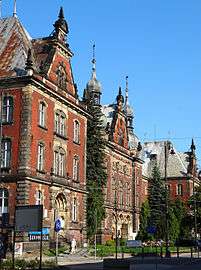 View with 3 entry gates onto Dworcowa st.
View with 3 entry gates onto Dworcowa st.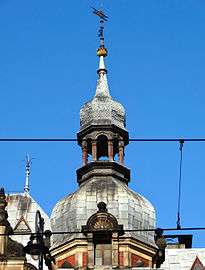
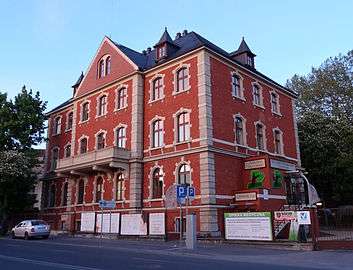 Adjacent building renovated
Adjacent building renovated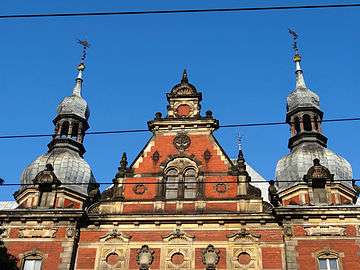 Detail of main gate gable
Detail of main gate gable Peak of a side entrance
Peak of a side entrance Detail of main facade, with conference room large windows
Detail of main facade, with conference room large windows
Indoors
- Entrance hall
- Landing of main stairs
- Ornate main hall ceiling
- Detail of column top
See also
Bibliography
| Wikimedia Commons has media related to Dyrekcja Kolei Wschodniej w Bydgoszczy. |
- (Polish) Jastrzębska-Puzowska Iwona, Winter Piotr: Budynek dawnej Dyrekcji Kolei Wschodniej w Bydgoszczy, [w:] Materiały do dziejów kultury i sztuki Bydgoszczy i regionu\, Zeszyt 1, Bydgoszcz 1996
- (Polish) Mierzyński, Jan: 125 rocznica powstania dyrekcji kolejowej w Bydgoszczy, [w:] Kronika Bydgoska V (1971–73), Bydgoszcz 1980
- (Polish) Parucka, Krystyna: Zabytki Bydgoszczy – minikatalog, Tifen Krystyna Parucka, Bydgoszcz 2008
References
- 1 2 3 4 5 6 7 8 9 Jastrzębska-Puzowska Iwona, Winter Piotr: "Budynek dawnej Dyrekcji Kolei Wschodniej w Bydgoszczy", "Materiały do dziejów kultury i sztuki Bydgoszczy i regionu", zeszyt 1. Bydgoszcz 1996
- ↑ PKP logistics
- ↑ M. Skowroński, Zakłady Naprawcze Taboru Kolejowego w okresie międzywojennym 1920-1939, w: Dzie- je ZNTK w Bydgoszczy, Bydgoszcz 1976, p.68-70,76
- ↑ Tomasz Zieliński "Stomatologia coraz bliżej", Express Bydgoski 9 października 2013
- ↑ Parucka, Krystyna: Zabytki Bydgoszczy – minikatalog, Tifen Krystyna Parucka, Bydgoszcz 2008
- ↑ Program Ochrony Środowiska dla miasta Bydgoszczy na lata 2013-2016 http://www.bip.um.bydgoszcz.pl/binary/721_tcm30-133312.pdf (34,2 MB)
